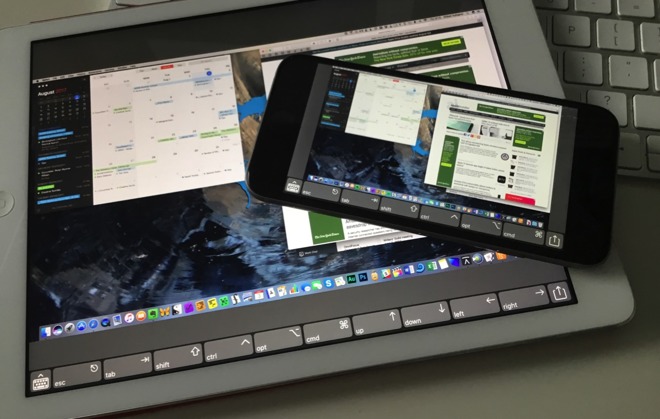Apple reportedly evaluating Apple Silicon-powered macOS on iPhone
A leaker reports that Apple is working on Apple Silicon prototypes with macOS running on the iPhone, which would allow a user to plug an iPhone into a dock or monitor, and have a full desktop experience.

Apple has previously denied that its Mac Catalyst project means that the Mac and iOS are coming together. However, now that the Mac will be running on Apple Silicon, a leaker says that the company is prototyping macOS on an iPhone.
"It is ready," the leaker continues, "they keep working on prototypes on the side, and are using this time to make it even better... but have 2 options ready (will go with only 1)."
"They are just waiting for other projects to fall into place," says the leaker. "Is 95% sure it's coming, but not 100%. It depends on a lot of factors."
Asked about whether the plan was for a dual-boot device, like Boot Camp allowing macOS or Windows on Intel Macs, MauriQHD said it "is more of a hybrid, I would say, but yes, at the very least, that would be the base of it all."
There have been attempts to get desktop operating systems onto phones before. The most notable effort is Samsung's DeX which was intended to make the Galaxy S8 become a desktop Chromebook-like machine, instead of displaying the handheld version of the operating system on the display.
Also, a separate Project Linda was aimed at making the Razer Phone become an Android laptop too, and was demonstrated at CES 2018.
Leaker MauriQHD has a limited track record as it pertains to Apple, but does have a good one with other technology firms. The Twitter thread continues with more information, although at times MauriQHD changes to say that the prototype is running on an iPad rather than an iPhone.
MauriQHD references both of these in the leak and says that Apple's two prototypes follow similar ideas of having a dockable system or making the phone run macOS. Apple has previously been reported as looking at making the iPhone become an accessory for a MacBook Pro, replacing its trackpad.

Apple has previously denied that its Mac Catalyst project means that the Mac and iOS are coming together. However, now that the Mac will be running on Apple Silicon, a leaker says that the company is prototyping macOS on an iPhone.
iPhone with MacOS
Apple working on Linda/Dex type of prototypes
the software work on it is insane
i cant even tell you how excited they are about the whole thing
im hearing-- Mauri QHD (@MauriQHD)
"It is ready," the leaker continues, "they keep working on prototypes on the side, and are using this time to make it even better... but have 2 options ready (will go with only 1)."
"They are just waiting for other projects to fall into place," says the leaker. "Is 95% sure it's coming, but not 100%. It depends on a lot of factors."
Asked about whether the plan was for a dual-boot device, like Boot Camp allowing macOS or Windows on Intel Macs, MauriQHD said it "is more of a hybrid, I would say, but yes, at the very least, that would be the base of it all."
There have been attempts to get desktop operating systems onto phones before. The most notable effort is Samsung's DeX which was intended to make the Galaxy S8 become a desktop Chromebook-like machine, instead of displaying the handheld version of the operating system on the display.
Also, a separate Project Linda was aimed at making the Razer Phone become an Android laptop too, and was demonstrated at CES 2018.
Leaker MauriQHD has a limited track record as it pertains to Apple, but does have a good one with other technology firms. The Twitter thread continues with more information, although at times MauriQHD changes to say that the prototype is running on an iPad rather than an iPhone.
MauriQHD references both of these in the leak and says that Apple's two prototypes follow similar ideas of having a dockable system or making the phone run macOS. Apple has previously been reported as looking at making the iPhone become an accessory for a MacBook Pro, replacing its trackpad.


Comments
Lot of nice ideas, but the hardware and software just wasn't ready.
/s
No. Just no.
Look at all those wires! And notice how literally the only things running there are browsers. That's ChromeOS in a nutshell: if it doesn't run in a browser (so that Google can build a profile of everything you do), it doesn't run.
BTW, just as Apple would deny any merging of iOS and macOS using a hybrid operating system, Google too denies any merging of Chrome and Android utilizing their own hybrid OS Fushia. I don't think either one of them have yet decided for certain but all signs sure point to it being an eventuality, and they're both spending engineering resources on it.
EDIT: An article link that follows the same thinking along with the why.
https://medium.com/@timventura/will-googles-fuschia-os-replace-android-chromium-35beb806612e
I don't see how this is limitation is overcome.
I'll gladly pay for an app which saves me time/headache because it was designed to do a few things well rather than shoehorning everything in a browser designed to do everything half-*ssed.
Mmmm.
They have now got a common hardware architecture.
They have scaleable app framework that runs on that architecture.
They have SwiftUI which will allow them to scale UIs with little effort.
The reason everyone fails when they try to do this is because they try to run the same apps at different screen sizes. I think they're looking at a dual boot/hybrid setup that will use the Universal Binary packages to carry multiple versions of the same app.
On the phone, it'll run the IOS version. When you plug it into the slot on your iMac terminal, it'll launch MacOS with the full MacOS version of the same app. The file formats are common.
I read a tweet the other day. One of the developers at the WWDC noted that if you run an iOS app on MacOS 11, it will be automatically replaced by the full MacOS version when the developer makes it available. I think Apple is very interested in making stuff as common as possible without compromising the simplicity of iOS and the versatility of MacOS. The way to do that begins with having a common architecture that can run both.
Really?! Maybe a docking station that includes the extra ports needed to connect a monitor, external hard drives and other devices that also bumps up the RAM and maybe adds a graphic card.